How To… | Teams Breakout Rooms
What is a breakout room?
Breakout rooms in Teams act as separate meeting rooms within an online meeting. Breakout rooms make it easy to divide your meetings into smaller groups to facilitate discussions, brainstorming sessions, or learning groups. Organisers can easily jump between breakout rooms, deliver announcements to all breakout rooms at once, and bring everyone back to the main meeting at any time. All meeting assets, such as meeting files, whiteboards, recordings, and transcripts are available for the organiser to review and leverage.
Contents
Interacting with breakout room participants
Creating breakout rooms
Note: In order to use breakout rooms, please ensure that the new meeting experience is enabled (Teams -> Settings -> General -> Check “Turn on new meeting experience”). Also make sure you have the latest Teams updates.
-
- Start the Teams meeting as normal. (We recommend starting it a little early so you have time to set up breakout rooms before other participants join).
- In the meeting controls, select the Breakout Rooms icon.

- Select the number of rooms you want from the drop-down menu (50 max). Then select whether you want Teams to assign people to rooms “Automatically”. If you wish to assign people to rooms yourself, select “Manually”.
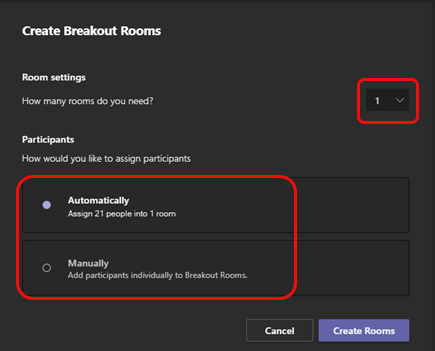
Note: This is the only time you can choose to have people automatically assigned to breakout rooms. You won’t be able to change this option later in the meeting.
If you chose Automatically, participants will be assigned to breakout rooms as soon as you open the rooms.
- Select Create Rooms.
Assign people to breakout rooms manually
If you chose to assign people Manually, follow these steps.
Note: Currently, participants who joined the meeting via PSTN or Teams devices can’t be assigned to rooms. We suggest using the main meeting as a breakout room for these people.
- Select Assign participants.
- Choose the people who will share a breakout room by selecting the check boxes next to their names.
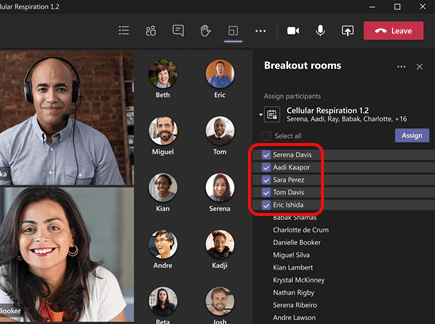
- Select Assign and then select a room for those people.
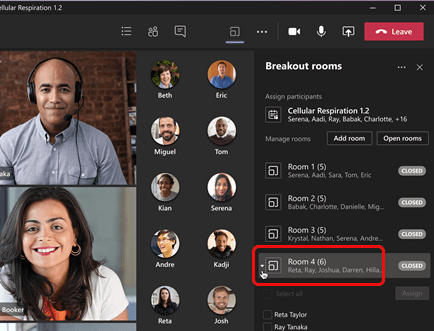
- Repeat steps 2 and 3 until everyone has been assigned to a room.
Rename the breakout rooms
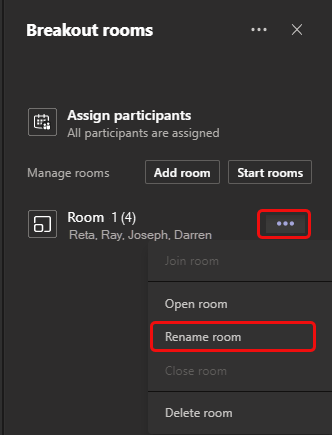
If you like, you can rename each room to reflect the group of people it contains, what they’ll be working on, or something else.
- Point to the room, select the More Options ellipsis (…) , and then Rename room.
- Enter the new name and select Rename room.
Tip: During the meeting you can decide to delete all the existing breakout rooms and set them up differently.
Start using the breakout rooms
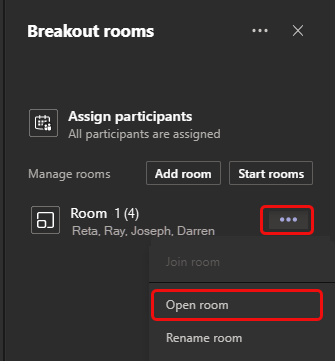 By default, meeting participants are moved to their assigned rooms as soon as you open the room.
By default, meeting participants are moved to their assigned rooms as soon as you open the room.
- To open all the rooms at the same time, select Start rooms.
- To open a single room, select the More Options ellipsis (…) next to the room and then Open. room.
You can open and close breakout rooms more than once during a meeting.
Interacting with breakout room participants
As meeting organiser, you can join any of the breakout rooms, contribute to any of the room chats, and send announcements to everyone.
Join a breakout room
Select More Options (…) next to the room and then Join room.
To leave a room, select Return.
Send an announcement to all breakout rooms
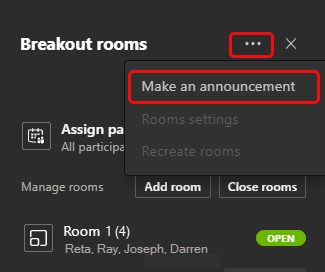 You may want to send announcements to give time updates, for example, or share discussion prompts.
You may want to send announcements to give time updates, for example, or share discussion prompts.
- Select More options (…) at the top of the Breakout rooms pane and then select Make an announcement.
- Enter your announcement and select Send.
Participants will receive a notification in their meeting chat to check for your announcement.
Chat in breakout rooms
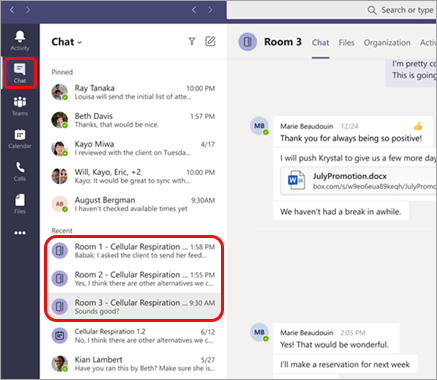
Each breakout room has its own chat, and all of the chats are available in your main Teams Chat list.
Here you can chat with the members of any breakout room.
Once you’ve joined a breakout room, you can also select the Chat speech bubble in the room to chat with the people there.
Note: When the breakout room closes, the room chat ends and cannot be continued. However, you’ll still be able to view the chat history and any shared files.
Closing breakout rooms
When you close the breakout rooms, the participants return to the main meeting.
1. To close rooms individually
- Select More options (…) next to the room, and then Close room.
2. To close all the rooms at the same time
- Select Close rooms.
You’ll know rooms have successfully closed when their status changes to Closed.
When everyone is back from their breakout rooms and you’re ready to meet as a larger group again, select Resume.
Note: Breakout rooms remain open until the organiser manually closes them, so they can be reused later in the meeting.
Additional options
Turn off automatic entry to breakout rooms
By default, participants are automatically moved into breakout rooms when they’re opened. When you turn off this option, participants receive a message asking them to join a breakout room. They select Join room (Join on a mobile device) before being moved.

- Select More options (…) at the top of the Breakout rooms pane and then select Rooms settings.
- Switch the toggle next to Automatically move people into opened rooms to off.
Meeting attendees can learn more about joining and participating in breakout rooms here: Join a breakout room in a Teams meeting.
Allow participants to return to main meeting
By default, this setting is off. Turning it on gives participants the option to leave their breakout rooms and return to the original meeting to rejoin the larger discussion.
- Select More options (…) at the top of the Breakout rooms pane and then select Rooms settings.
- Switch the toggle next to Participants can return to the main meeting to on.
Move someone to a different breakout room
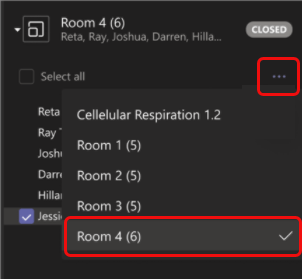
Note: Currently, participants can be moved only when breakout rooms are closed.
- Expand the list of participants under a breakout room.
- Point to someone‘s name and select the check box that appears.
- Select More options (…) and then the breakout room you want to move that person to.
Add an additional breakout room
Select Add room in the Breakout rooms pane.
Delete a breakout room
Point to the room, select More options  , and then Delete room.
, and then Delete room.
Recreate breakout rooms from scratch
During a meeting, you can return to the beginning of the breakout rooms process to reconfigure the rooms and assignments.
- Select More options
 at the top of the Breakout rooms pane and then select Recreate rooms.
at the top of the Breakout rooms pane and then select Recreate rooms. - Follow the instructions above to create new breakout rooms and assign people to them.
Using breakout rooms from different devices
- The meeting organiser can start a breakout room on the desktop client only.
- Participants can join a breakout room from desktop, web, or mobile. Microsoft Teams Rooms do not have breakout room capabilities yet.
- Participants logged in from multiple devices will have all end points join the same breakout room.
How can I use breakout rooms as an educator?
- Educators will have the option to push students into the breakout rooms and pull them back to the main meeting as required, without any additional action needed by the student.
- Students can be assigned to breakout rooms, join breakout rooms, use the whiteboard, or screen share if allowed to in normal school meetings, re-join the main meeting, and see their breakout room chat.
- Since breakout rooms are still classed as Teams meetings, the same security policies and options apply to the breakout room.